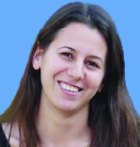Sivan Refaely-Abramson 2013-2014

- Institution of PhD:
- Weizmann Institute of Science
- Academic Discipline of PhD:
- Quantum Mechanics
- PhD Advisor/s:
- Prof. Leeor Kronik
- Dissertation Topic:
- A Generalization Of The Optimally-Tuned Range-Separated Hybrid Scheme To The Solid-State
- Year Awarded PhD:
- 2015
- Institution of Postdoc:
- University of California, Berkeley
- Present Institution:
- Weizmann Institute of Science
- Present Academic Position:
- Senior Scientist, Department of Materials and Interfaces
- Email:
- sivan.abramson@weizmann.ac.il
- CV
- Publications
Sivan Rafaely-Abramson was raised in Moshav Ma’ale Gamla on the Golan Heights. As a student in the combined honors program in physics and chemistry at the Hebrew University of Jerusalem, she completed an undergraduate research project under the supervision of Prof. Raphael D. Levine in the Department of Physical Chemistry. After receiving her BSc, Sivan joined Prof. Leeor Kronik’s group in the direct PhD track at the Weizmann Institute of Science, where she also worked as a teaching assistant in quantum mechanics courses for MSc students.
Sivan’s current research is in the field of computational quantum chemistry within the framework of Density Functional Theory. In collaboration with Prof. Roi Baer of the Hebrew University as well as other research groups in Europe and the United States, she is focusing on the development of new computational tools to predict the chemical and physical behavior of novel materials that are considered promising for sustainable energy production,. The group’s recent research, in which they used and developed an optimally-tuned range-separated hybrid functional scheme to accurately predict electronic structures of challenging gas-phase molecules of photovoltaic interest, was summarized in two papers in the APS journals Physical Review B and Physical Review Letters. Sivan was also part of a team that developed a new functional form that captures the electronic nature of organic molecular crystals in the bulk; this work was recently published in Physical Review B.
